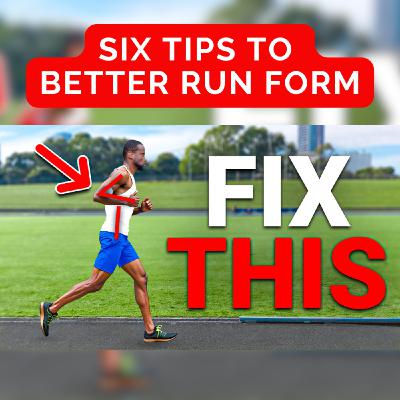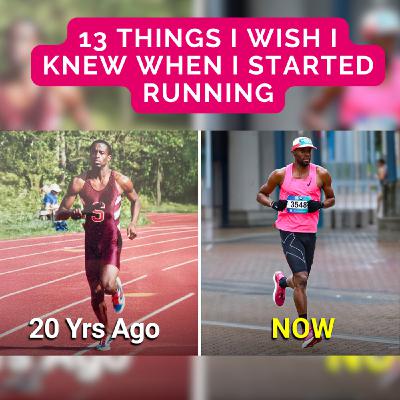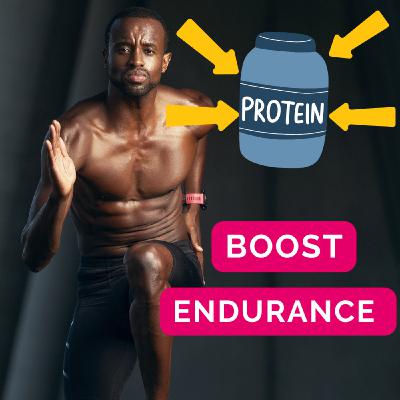Discover The 1% Better Runner with DLake
The 1% Better Runner with DLake

The 1% Better Runner with DLake
Author: Daren DLake
Subscribed: 29Played: 655Subscribe
Share
© DLake Creates PTY LTD
Description
This is a podcast about how runners can live better lives through consistent self-improvement.
Unlike other running brands, The 1% Better Runner focuses on how small, daily habit improvements ripple into broader life success, helping runners perform better both on and off the road, track, or dirt.
I’m Daren DLake: Certified running and nutrition coach, Sub-3-hour marathoner and 10-hour Ironman finisher.
Since 1996, I’ve been helping other self-coached runners, researching, and experimenting on how to better myself 1% each day.
A few times a week, I’ll drop how I’m tweaking my training, sticking to habits when life’s messy, and cool stuff from coaches and health pros. It’s a no-BS cheat sheet for building better habits—not just for running, but for work, relationships, and personal growth too.
Join thousands of other committed runners listening to the most exciting run and endurance sports content on the internet and get more tactics and strategies in your inbox each week.
Bonus - Get my free 30-day base and habits training plan when you sign up for the free newsletter here.
PS - Podcasting is very "1-way," so let's fix that. Hit us up if you have any feedback, want to collaborate, or just wanna tell me about your training. On Instagram @dlakecreates or talk@dlakecreates.com
Hosted on Acast. See acast.com/privacy for more information.
203 Episodes
Reverse
What does a smarter marathon training plan actually look like?"When marathon training pushes your limits, the line between progress and injury becomes dangerously thin. In this episode, we break down a 79-minute half marathoner’s aggressive training plan, where it went wrong, and how smarter strategies can unlock better results. Learn the key adjustments to make your marathon training sustainable, avoid common injuries, and still hit your goals. Whether you’re self-coached or just seeking better guidance, this episode will reshape the way you think about training.Timestamps00:00:00 Introduction00:01:10 Meet the Runner00:03:00 Analyzing the Training Plan00:05:00 Problems with VO2 Max Workouts00:08:00 IT Band Pain Explained00:09:19 The Cross-Training Solution00:11:33 Adjusting Training Expectations00:13:45 Strength Training for Injury Prevention00:14:50 Delayed Gratification for Marathon Success00:16:30 Next Steps for a Smarter Marathon PlanLinks & Future LearningsFix & Prevent IT Band issues with this - https://youtu.be/VPkMRvnX8LM?si=dtZUBPxuUNyneh-mHow to do 12x400m Intervals the right way - https://youtu.be/NrUVGwbPWxo?si=XMcrKviJcvXK-cFpHow to do Cross-Training the right way for runners - https://youtu.be/tLLhtRfx2uI📈 Get your free 30-day 1% better base training & habits guide - https://dlakecreates.com/basefree🎧 Listen, read and learn more here https://dlakecreates.com/nateNate on Instagram - https://www.instagram.com/nate_word/Instagram - https://instagram.com/dlakecreatesStrava https://www.strava.com/athletes/120507 Hosted on Acast. See acast.com/privacy for more information.
What’s the one thing most runners get wrong about “easy training”?Is your “easy run” truly setting the stage for your success—or quietly sabotaging your training? In this episode, we uncover how to correctly define easy training, why heart rate zones need to be personalized, and how to avoid the pitfalls of the gray zone. You’ll learn practical tests to determine your effort levels and discover why even the pros treat “easy” differently. Whether you’re a beginner or experienced runner, these insights will help you train smarter and perform better.Timestamps[00:00] Are your easy runs setting you up for success or sabotaging your progress?[01:15] What makes a run truly "easy"? Mental arithmetic and breathing tests explained.[02:41] Using the breathing countdown test to check heart rate accuracy.[04:09] Can a run ever be "too easy"? Understanding objectives and recovery.[07:57] Why Maffetone's principles work differently for advanced and beginner runners.[09:43] The gap between easy and race paces for elites versus everyday runners.[10:01] Resting heart rates and the importance of heart rate reserve in training.[12:20] Debunking myths about maximum and Maffetone heart rates.[13:18] Customizing heart rate zones for higher resting and maximum heart rates.[15:00] How base training builds longevity and aerobic fitness.Key TakeawaysUnderstand what "easy" really means: Learn why your easy runs should feel effortless and how the nasal breathing or chatting tests can help define them.Heart rate zones are personal: Discover how factors like your fitness level and resting heart rate impact the effectiveness of heart rate training.Balance is the key to progress: Understand how alternating between truly easy runs and challenging efforts prevents overtraining and maximizes results.Links & Learnings📈 Get your free 30-day 1% better base training & habits guide - https://dlakecreates.com/basefree🎧 Listen, read and learn more here https://dlakecreates.com/easyrunningFollow me on Instagram - https://instagram.com/dlakecreatesFollow Mike Trees on Instagram - https://instagram.com/run.nrgFollow me on Strava - https://www.strava.com/athletes/120507IMAT Heart Rate https://dlakecreates.com/imatMaffetone 180 Formula https://dlakecreates.com/maf Hosted on Acast. See acast.com/privacy for more information.
Find out how to use cross-training to enhance your running and avoid injuries.Runners, how do you feel about this statement? Cross-training for the majority of your training will not help you run your fastest marathon.But in that same breath cross-training can also be a game-changer for runners—but only if used correctly. Confusing? Yeah that’s how I was before I made this episode.But in this episode, I break down the science and strategy behind cross-training, including what it is, why it matters, and how to implement it effectively. Whether you’re a beginner, an injury-prone runner, or a seasoned marathoner, you’ll discover how to leverage cross-training without sacrificing your running performance.Plus, I’ll share specific activities and a free guide to help you apply these insights to your own training.Key TakeawaysCross-training enhances recovery, reduces injury risk, and builds complementary strength for better running.Not all cross-training activities equally benefit running—specificity is crucial.A well-balanced approach to cross-training depends on your goals, experience, and training phase.Timestamps[00:00:00] Why cross-training won’t help you run your fastest marathon[00:00:41] Overview of Cross-Training Topics[00:01:36] What Is Cross-Training?[00:03:05] Benefits of Cross-Training for Runners[00:04:39] Who Benefits Most from Cross-Training?[00:06:47] Strength Training as Cross-Training[00:07:48] How to Do Cross-Training Right[00:10:01] In-Season vs. Off-Season Cross-Training[00:12:31] Cross-Training Activities Ranked[00:14:46] Principle/Law of Specificity and Final Thoughts[00:15:35] How Running Helps Cycling Performance but Cycling doesn’t Help Running Performance[00:16:39] Final ThoughtsLinks & Future Learnings📈 Get your free 30-day 1% better base training & habits guide - https://dlakecreates.com/crosstrainfree🎧 Listen, read, and learn more here https://dlakecreates.com/crosstrainDaren on Instagram - https://instagram.com/dlakecreatesDaren on Strava - https://www.strava.com/athletes/120507Learn more about how to lift like a pro runner in your offseason - https://dlakecreates.com/axisMarathon Handbook - Cross Training for runners - https://marathonhandbook.com/cross-training-for-runners/Runner's Guide to Elliptical Training - https://lauranorrisrunning.com/runners-guide-to-the-elliptical/How many miles equals running from other activities? - https://routeonecycling.com/how-many-miles-cycling-equals-running-the-13-ratio-is-wrong/ Hosted on Acast. See acast.com/privacy for more information.
Your running form could make or break your next race, fixing it could be easier than you think.Fixing your running form could be the easiest way to run faster, longer, and with less effort. This episode simplifies the myths about foot strike, stride length, and posture, replacing them with actionable advice to help you improve efficiency and reduce injuries. Whether you’re a casual jogger or a seasoned racer, these six form fixes will change how you run for good.Key Takeaways:Running form isn’t about aesthetics but finding what works efficiently for your body.Overstriding, not heel striking, is the root cause of many common running injuries.Simple changes in posture, cadence, and stride can significantly improve performance.Timestamps:[00:00] Why running form impacts your performance[00:10] Dispelling myths about running aesthetics[00:32] What is running form and why does it matter?[02:02] The truth about foot strike and efficiency & heel striking[03:04] Mid foot striking[03:26] Forefoot striking[04:06] Posture[04:40] Using arm swing to maintain balance[05:10] How to fix your run form - free download[05:45] Breathing[06:42] Stride Length[07:46] Cadence tips for smoother, lighter runs[08:44] Final Thoughts - Don’t overthink it - take your timeLinks & Future Learnings📈 Get your free 6 month 1% better your cadence cadence & habits guide - https://dlakecreates.com/cadencefree 🎧 Listen, read and learn more here https://dlakecreates.com/runformHeel Strike Study - https://pubmed.ncbi.nlm.nih.gov/30356626/DLake Runs on Instagram - https://instagram.com/dlakecreatesDLake Runs on Strava - https://www.strava.com/athletes/120507 Hosted on Acast. See acast.com/privacy for more information.
Why is planning next year’s runs about more than just resolutions?This episode dives into 43 hard-earned lessons that every runner—and even non-runners—can use to improve their approach to life, fitness, and goal-setting. Discover the power of reflection, the secrets to sustainable training, and the strategies that help balance effort, health, and happiness. Whether you’re a beginner or a seasoned athlete, you’ll find insights to take your running and personal growth to the next level.Key TakeawaysReflecting on past runs can shape a more productive and enjoyable future.Balancing effort and recovery is critical to running longevity and enjoyment.The virtuous cycle of running, strength training, and feeling good helps you improve sustainably.Timestamps[00:00] Reflecting on past challenges to plan the future[00:25] How to audit your running year effectively[01:03] The 87% rule and its benefits[02:00] Why holding back in races can be the smart choice[03:00] Running metaphors for life and work[04:00] Genetics vs. effort in running performance[05:22] How to avoid the vicious run cycle[06:00] Loving the off-season for growth[07:16] Why running should fit into your life, not the other way around[10:25] Long-term consistency as the key to running successLinks & Future Learnings📈 Get your free 30-day 1% better base training & habits guide - https://dlakecreates.com/basefree🎧 Listen, read and learn more here https://dlakecreates.com/40things3🎧 Listen, read, and learn more here https://dlakecreates.com/40things3🎧 Part 2 is here https://dlakecreates.com/running-tips-26-years-experience/🎧 Part1 is here https://dlakecreates.substack.com/p/40-things-about-running-that-i-wishhttps://instagram.com/dlakecreateshttps://www.strava.com/athletes/120507 Hosted on Acast. See acast.com/privacy for more information.
Why does this runner loop a soccer field instead of exploring scenic trails?Learn how simple habits and small daily changes can transform your running performance. From breaking mental barriers to establishing a consistent training routine, this episode shares actionable insights from a runner striving to go sub-3 hours. Whether you're training for a marathon or just starting, these tips will help you become a smarter, more resilient athlete.Key TakeawaysSimple habits like running the same route can reduce decision fatigue and improve focus.Running without music can build mental resilience and deepen the running experience.Incremental improvement leads to long-term success—1% better every day matters.Timestamps[00:00:00] Introduction to the 90-minute long run and marathon training goals.[00:01:17] Chris’s current marathon focus and goal of breaking sub-3 hours.[00:02:18] The strategy: pacing smartly and avoiding common mistakes in long runs.[00:03:22] Chris’s soccer background and how it prepared him for running.[00:04:38] Why Chris began running consistently and the mental benefits of the habit.[00:05:19] The power of route consistency and why Centennial Park is a favorite.[00:06:09] Running laps on a soccer field: mental challenges and lessons learned.[00:06:52] Chris’s transition to running without music and the mental toughness it builds.[00:07:22] Key advice for runners: staying consistent and running for life.[00:08:00] Closing thoughts: how small habits can lead to marathon breakthroughs.Links & LearningsThe One Percent Better Runner NewsletterDLake Runs on InstagramChris on Strava Hosted on Acast. See acast.com/privacy for more information.
Are you really racing the distance at your highest potential? How much do you need to suffer? And what does it take to race a 5k? At your peak effort and intelligence, stick around, don't worry, because I'm going to answer all those questions and more by giving you my top 12, 12 tips on racing the 5k that I've learned from my experience, research, and talking with all of the experts on the 5k.Running your best 5K takes more than just lacing up your shoes—it’s about training smarter, not harder. From mastering the 80/20 rule and incorporating targeted strength training to reframing your mindset on race day, this episode provides 12 actionable tips to elevate your performance. Whether you’re chasing a personal best or tackling a 5K for the first time, these strategies will help you hit the ground running.Timestamps Of What You'll Learn[00:00] The 5K: A Gateway to Bigger Challenges[00:22] Are You Reaching Your Full Potential?[01:17] Structure Your Training Into Periods & Blocks[02:51] Use The 80/20 Rule[04:09] Vary Your Speedwork[05:59] Strength Training Tips for Runners[06:45] Nutrition’s Role in Training and Performance[07:47] How To Actually Run Your Fastest 5k[08:37] Why Cross-Training Improves Your 5K[09:47] Time Trials: The Key to Mental Toughness[10:19] Dial In Your Recovery[11:24] Reframing Your 5K Mindset[13:17] The 1% Better Runner's Virtous & Viscious Cycle[14:38] Preparing for Race Day: Warm-Ups and PacingKey Takeaways80/20 Training Rule: Focus 80% on easy runs and 20% on speed to maximize gains.Strength Training for Runners: Essential for injury prevention and better performance.Reframing Goals: Focus on your best performance, not just a faster time.Links & Learnings📈 Get your free 1% better in 6-weeks 5k training and habits guide🎧 Listen, read and learn more hereOPB - Virtous vs. Viscious Run Cyclehttps://instagram.com/dlakecreateshttps://www.strava.com/athletes/120507 Hosted on Acast. See acast.com/privacy for more information.
Every time you skip recovery, you’re leaving future progress on the table.What if your running habits could change your life? In this episode, you’ll discover how structure and pacing can unlock both physical and mental breakthroughs. Greg Pearson, a former pro soccer player turned running coach, shares the mindset shifts, recovery strategies, and training practices that have helped him and his athletes consistently improve. Learn what it takes to make running sustainable for life, not just a season.Timestamps of What You'll Get From This[00:00] Why recovery is the key to progress.[00:17] Pacing: The ultimate superpower for runners.[00:53] Easy runs and building your best fitness.[01:36] Lessons from a pro soccer player turned runner.[04:07] The value of structure in athletic success.[08:36] Identity shifts and the transition to running.[12:11] Coaching philosophy: Helping runners achieve goals sustainably.[13:26] Mental growth through running challenges.[18:23] The importance of starting small and scaling smartly.[20:40] "You cannot fail if you do not quit."Links & LearningsGet Free 30-day base training and habits guide here The One Percent Better Runner NewsletterDLake Runs on InstagramGreg on InstagramJoin Greg’s Coaching Waitlist Hosted on Acast. See acast.com/privacy for more information.
Imagine running faster and stronger but with less effort and all from one small adjustment. What is it? Increasing your run cadence - But how do you actually do it? Listen on to find out.Discover how to unlock your full running potential with one small yet powerful adjustment—your cadence. Learn why it matters for efficiency, injury prevention, and speed, and explore 18 proven strategies to improve it at your own pace.From beginner-friendly tweaks like stride shortening to advanced drills and strength training, this episode delivers a roadmap to running stronger, faster, and injury-free.Get our Free 6 month plan to increase your run cadenceTimestamps of What You’ll Learn[00:00] Introduction: How cadence can improve your running.[0:21] Why I’m obsessed with run cadence[1:12] Why you should listen to me[1:40] What You will get from this[2:29] What is run cadence exactly?[2:40] Why should we care about cadence?[03:52] Over-striding explained: Why it leads to injuries like runner's knee.[04:25] How to measure your cadence with simple tools or tech.[05:53] The 180 steps per minute myth and its applicability.[06:30] Adjusting cadence for different body types and heights.[09:50] Beginner strategies for improving cadence: Shorter strides, metronomes, and playlists.[14:09] Advanced techniques: Barefoot running, hill repeats, and plyometric drills.[16:10] Strength training tips for building power and elasticity.[16:42] Working with professionals to tailor your cadence improvement plan.[18:00] Final thoughts: Long-term benefits of gradual cadence changes.Key TakeawaysWhy Cadence Matters: Higher cadence can improve running efficiency, reduce injury risk, and potentially boost speed—when done correctly.How to Measure Cadence: Tools like smartwatches and apps simplify tracking your steps per minute for more accurate adjustments.Step-by-Step Cadence Training: From stride shortening to strength training, there are 18 actionable tips to gradually enhance your cadence safely.Links & Future Learnings Free 6 month plan to increase your run cadenceWatch, read and listen to this on your next run or workout7 tips to Improve your running formUse Run Form Drills and Plyometrics to Become an Injury-Free MonstersDr. Marie Whitt Fit on InstagramDr. Marie Whitt Fit on YouTubeDLake Runs on InstagramScientific Study - Effect of Increasing Running Cadence on Peak Impact Force in an Outdoor Environment Hosted on Acast. See acast.com/privacy for more information.
Want to make every run feel a little easier? Try this approach for 1% better results.In this episode, you’ll learn why small, intentional adjustments in your training can create massive improvements in the long run. From understanding the science behind beta-alanine as an endurance booster to rethinking the way you approach fartlek workouts, this session covers the incremental changes that lead to 1% daily gains. Plus, you’ll learn why choosing the right weather app matters more than you might think and how to make better decisions based on accurate forecasts.Timestamps[00:00] Introduction to 1% Better Philosophy[00:36] Why long-term gains matter more than quick fixes[01:12] Beta-alanine: The slow-burn supplement for endurance[02:24] How beta alanine reduces muscle fatigue[03:49] Managing side effects: Tips for a comfortable dosage[05:41] The importance of checking accurate weather forecasts[08:12] Why most weather apps aren’t reliable[10:27] Tackling fartlek workouts with structure[12:33] Effective gear planning based on accurate forecasts[13:10] Closing thoughts on long-term commitment in runningKey TakeawaysSlow Progress with Supplements: Beta-alanine isn’t an instant boost; it requires weeks of consistent use to benefit endurance and reduce fatigue.Structured Fartlek Workouts: By adding structure to fartlek sessions, runners can better manage pacing and avoid injury, making the workout more effective.Choosing the Right Weather App: Not all weather apps are accurate. Selecting one tailored to your location can make a big difference in planning your runs.Links For GreatnessGet your free 1% better 30-day guide to consistencyWatch and read the full episode hereDLake Runs on InstagramFollow my training on Strava Hosted on Acast. See acast.com/privacy for more information.
Training inconsistently? Here’s how that might be holding back your race goals.In this episode, we dive into what separates fast runners from the fastest: consistency. Learn from Audrey’s journey to shave time off her 5K and uncover what training habits might be keeping you from your personal best. We’ll cover her favorite dynamic warm-ups, interval tips, and lifestyle tweaks to keep you injury-free and consistently on track for your goals. Whether you're an elite runner or just getting started, this episode has practical takeaways for anyone looking to improve!Timestamps of What You’ll Learn[00:00] Why Consistency is Key to Training[01:09] First Time Meeting Audrey[01:45] Barriers to Breaking the 15-Minute Mark[02:42] Dynamic Warm-Up Routine Breakdown[03:35] Goals and Fitness Priorities[04:17] Fun Fuel Choices for Training Days[06:06] Learning from Interval Mistakes[07:52] Final 400m Interval Push[09:02] How to Train for Speed in 800m[11:25] Breaking Bad Habits for ConsistencyLinks For GreatnessGet your free 1% better 30-day guide to consistencyDLake Runs on InstagramAudrey on InstagramWatch and read the full episode Hosted on Acast. See acast.com/privacy for more information.
Are you too mindful on your runs? It might be time to dial it back.I dive into the surprising downside of being too mindful during your runs and how it can disrupt your flow and performance. We explore the fine line between conscious awareness and muscle memory, revealing how to harness mindfulness effectively without letting it derail your progress.Learn how to find the right balance and implement techniques that keep you in the zone, effortlessly improving your running experience.TIMESTAMPS OF WHAT YOU'LL LEARN- [00:00:00] - Introduction and Overview- [00:00:15] - Setting the Stage for the Discussion on Mindfulness in Running- [00:01:15] - The 14-Mile Run Story: A Personal Story Where Mindfulness Backfired During a Long Run- [00:02:22] - The Moment of Disruption: How Being Overly Mindful Threw Off My Stride and Rhythm- [00:02:49] - Science of Mindfulness: Exploring Research on Mindfulness and Automaticity in Athletic Performance- [00:03:54] - Balancing Awareness and Flow: Finding the Right Balance Between Conscious Awareness and Muscle Memory- [00:04:30] - Challenges of Excessive Mindfulness: Too Much Mindfulness Can Hinder Running Performance- [00:06:11] - Real-World Application: Practical Advice on Applying Mindfulness Without Overthinking- [00:08:01] - Importance of Muscle Memory: Understanding the Role of Muscle Memory in Sustaining Long Runs- [00:08:51] - Achieving Meditative Flow: Techniques for Entering a Flow State Without Disrupting Your Run- [00:10:37] - Final Thoughts and Tips: Concluding Insights and Actionable Advice for Mindful RunningLINKS & LEARNINGS- The One Percent Better Runner Newsletter - https://dlakecreates.com/news- DLake Runs on Instagram - https://instagram.com/dlakecreates- Can Mindfulness Backfire? https://www.psychologytoday.com/us/blog/the-athletes-way/201311/can-mindfulness-backfire- Listen, read and learn more here https://dlakecreates.com/mindful Hosted on Acast. See acast.com/privacy for more information.
What if running farther wasn’t about speed, but strategy?In this episode, we dive into the essential strategies to keep you running stronger and longer, without the burnout. Learn the time-tested techniques that focus on stamina over speed, including how to prevent injuries, fuel your body effectively, and make the right adjustments in your routine. These tips will help you push through barriers and become a more resilient runner, all while feeling fresher on every run. Whether you're preparing for your first marathon or just want to improve your daily runs, these strategies are your foundation for long-term success.Get your free run farther 1% better each day for 30 days guide here Timestamps & Learnings[00:00] Cavemen and aerobic base[01:39] #1 PRACTICE RUNNING SLOW[02:12] #2 USE THE TALK TEST[03:48] #3 FIND A RACE AND/OR JOIN A CLUB[04:28] 8 MORE KEY STEPS THAT WILL WORK EVEN BETTER[05:19] #4 STRENGTH TRAINING[06:47] #5 FOOTWEAR[08:01] #6 DIET & NUTRITION[09:38] #7 RECOVERY STRATEGIES[11:04] #8 CROSS TRAINING[12:02] #9 TRACK PROGRESS[12:42] #10 FOLLOW THE 10% RULE[13:48] #11 MENTAL STRATEGIES AND DEALING WITH A SETBACK[15:11] FINAL THOUGHTSLinks & LearningsGet your free run farther 1% better each day for 30 days guide here The One Percent Better Runner NewsletterEverything You need to know about Base Zone 2 Aerobic Running ToolkitDaren DLake on InstagramJames Dunn on how to run far without tiringRun Strength Training Toolkit5 zone vs 3 zone HR training explainedCan a new or experienced runner out run a bad dietWhy rest, sleep and recovery are so importantMindfulness and getting 1% better each day/month/year Hosted on Acast. See acast.com/privacy for more information.
Is it possible to run faster with a low heart rate? Here's how it works.Download the free 1% Better runner 30 day plan to run faster with a low heart rate Want to take your running to the next level while avoiding burnout? This will help you.In this episode, you'll join me on a journey through Zone 2 training—learning how to build endurance, improve speed, and keep your heart rate in check. We’ll dive into the details of low heart rate training, covering everything from warm-ups to ideal fueling strategies. Whether you’re training for a marathon or simply want to optimize your daily runs, this guide will help you unlock a new level of performance with ease.Timestamps[00:00] - Introduction to the City Marathon Training Group[00:24] - Overview of Zone 2 Training for Endurance[01:05] - Goal Setting: The Maffetone Test[01:30] - Warm-Up Routine and Importance[03:14] - Sliding Into High Zone 2[05:11] - The Progression Pyramid and Its Benefits[07:38] - Understanding Zone 2 Efficiency in Training[09:30] - The Role of Specificity in Training at High Zone 2[13:16] - How Fueling Impacts Long Run Recovery[15:15] - Final Thoughts on the 1% Consistency PrincipleKey IdeasRunning in Zone 2 can improve endurance and speed without risking burnout.A well-structured warm-up is essential to transition smoothly into low-intensity running zones.Combining heart rate and effort levels helps maintain optimal pace throughout long runs.Links & LearningsDownload the free 1% Better runner 30 day plan to run faster with a low heart rate Watch & Read the episode hereMAF Runs explainedNorwegian Method - Jakeb Ingebrigsten’s Double Threshold Training SessionThe One Percent Better Runner NewsletterDLake Runs on Instagram Hosted on Acast. See acast.com/privacy for more information.
Ever wondered what the perfect running shoe feels like? Let me tell you about mine.In this episode, you’ll discover the gear that’s transforming my runs, including my favorite all-around running shoe, an unexpected heart rate monitor upgrade, and a singlet designed to stay in place no matter how fast you go. I’ll explain why the Altra Escalante 3 shoe is my top choice for daily runs and why the CoosPro Optical Arm Band HR Monitor is a serious competitor to chest straps. Plus, I’ll dive into the philosophy behind KZN RUN gear and why it’s more than just clothing. If you’re looking to optimize your runs, this episode is packed with insights you can apply today.Watch or read this hereWhat You’ll LearnIntroduction to running gear, shoes, and techThe Altra Escalante 3: Why it's the best everyday shoeMy experience with minimalist vs. supportive running shoesTransitioning into new shoes safelyCoosPro Optical Arm Band Heart Rate Monitor: My reviewComparing the CoosPro to chest straps: What's better?The KZN RUN singlet and what makes it stand outKaizen philosophy and improving your runs 1% each dayNOTE: I know the Escalante 4's have dropped and I'll be getting those when my 3's wear out. At this pace, it might be a while! Key ConceptsVersatile Running ShoesAltra Escalante 3 combines support and flexibility for everyday running and lifting.Accurate HR MonitoringThe CoosPro Optical Arm Band is a reliable and affordable alternative to chest straps.Philosophy-Driven GearKZN RUN singlet uses smart designLinks & Learnings3 Zone vs 5 Zone Heart Rate Training - Which is best?Altra Esclante 4CoosPo HRM Arm BandKZN RunsThe One Percent Better Runner NewsletterDLake Runs on InstagramWatch or read this here Hosted on Acast. See acast.com/privacy for more information.
Imagine a tool that could instantly upgrade your running game—here it is. As a bonus, we’ll explain Vo2 Max for running to you simply.In this episode, discover how to turn your VO2 max workouts from frustrating guesswork into precision training that delivers real results. You’ll learn how to use a simple yet powerful tool to nail your paces, avoid common mistakes, and build a training strategy that works for your specific goals. This isn’t just about running faster—it's about understanding the science behind your workouts to train smarter, not harder.Get the free 30 day plan, checklist and quick start guide here.Timestamps of what you’ll learn[00:00] - Setting the stage: Interval workout and VO2 max explained[01:29] - Introduction to the VDOT calculator and how it can improve your training[03:55] - Step-by-step guide: How to use the VDOT calculator effectively[06:45] - Common mistakes in VO2 max training and how to avoid them[08:46] - Aerobic vs anaerobic energy systems: The car engine analogy[13:52] - VO2 max workouts: Practical examples and how to maximize their effectiveness[17:53] - Understanding the balance between VO2 max, heart rate, and training blocks[23:27] - Favorite VO2 max workouts: 400m intervals and flow states[27:49] - The difference between VO2 max and lactic tolerance sessions[31:50] - Why VO2 max is a useful but not definitive measure of performanceLinks & LearningsGet the free 30 day plan, checklist and quick start guide here.The One Percent Better Runner NewsletterDLake Runs on InstagramGet the free tool to help you with Vo2 Max in your training here Hosted on Acast. See acast.com/privacy for more information.
Ever wonder how just 1% better daily can transform your running journey?In this episode, you’ll learn the art of becoming 1% better... every single day... for a decade. We dive deep into the mindsets, strategies, and core principles that transform running into a powerful tool for growth in every part of your life.You’ll discover how to pick the right races, stay consistent despite life’s inevitable interruptions, and leverage biohacking techniques to optimize your performance.The goal? To make running not just about finishing faster but about sustaining a lifelong journey of improvement—one small win at a time.Timestamps of what you'll learn[00:00] - Introduction to the 1% Better Journey: Why small changes lead to big results.[00:48] - The Three Reasons I Started Running: Biohacking, mindfulness, and chasing a feeling.[02:20] - Cal Newport's Compound Growth Theory and How It Applies to Running.[03:10] - Lessons from the 800m Track Days: How to build endurance and speed.[04:02] - The Mindful Runner: Balancing meditation and movement for better performance.[05:17] - The 1% Better Formula Explained: Belief, focus, and patience in practice.[05:39] - Why the Marathon Isn't for Me: Choosing the right race to avoid burnout.[06:32] - DIY Races and the Power of Flexibility: How to stay committed even when life gets in the way.[07:25] - Year-by-Year Recap: The highs, lows, and lessons from each race.[09:45] - Final Reflections: Why slow growth is the most powerful growth for runners.Links & LearningsThe One Percent Better Runner NewsletterDLake Runs on InstagramThe last 7 years of half marathon resultsHow to master the art of continuous improvement - James ClearSteve Prefontaine without LimitsCheck my strava and follow me for more inspiration and movitation Hosted on Acast. See acast.com/privacy for more information.
Watch and read this hereIn this episode you’re going to find out what happens at the intersection where science meets the pavement – the quest for ultimate running performance. We’ll dissect the importance of power and speed in your resistance/weight training. I’ll answer the question for runners; where does power, speed, strength, muscle endurance, and hypertrophy fit in to an already crowded training plan? Especially for distance runners?! I’ll even tell my own story of how I switched gears in my training and embraced the fusion of lifting with speed and power. It wasn't just a change in routine – it was a transformation in philosophy.This episode isn't just about challenging how your muscles move; it's about challenging your mindset.By the end of this, you'll not only rethink your 1% better training habits approach but you’ll also… (yes get ready for the laundry list)Become more resilient so you have less niggling injuriesGenerally more bounceDevelop that extra gear in your runningBecome more efficient so your easy runs are close to the same speed as your more intense sessionsDevelop your secret weapon at the end of races — speed reserve (more on that later)And overall take your training to the next level.Yes, that’s a big promise so let’s see if I can deliver.Timestamps[00:01:15] - The Benefits of Resistance Training for Runners[00:03:13] - Speed Strength vs. Strength Speed Explained[00:04:16] - The Role of Power in Distance Running[00:04:47] - My Resistance Training Revelation[00:05:19] - Introducing the Experts at Axis Performance Labs[00:07:34] - What This Episode Is Not About[00:10:11] - Defining Power and Speed in Athletic Performance[00:11:03] - Why Speed Reserve is your secret weapon[00:11:36] - Differentiating Between Power, Speed, Strength, and Hypertrophy[00:12:29] - Why an Objective Sports Professional is Crucial[00:13:53] - My First Assessment and Baseline Testing[00:16:09] - The Training Plan in Action and Progression[00:17:01] - Reassessment and Results After 10 Weeks[00:18:31] - The Future of My Training and Its Impact on Running[00:22:49] - The 2 reasons why runners don’t like to do resistance training[00:26:33] - Why Axis does the type of testing for power, force and strength[00:30:21] - Why Axis choose this specific training plan for meLinks & LearningsThe difference between speed strength and strength speedTesting tools: GymAware & Vald Performance ForceDecksHuberman Labs Guest Series with Dr. Andy GalpinNCBI Study on strength training and runningAxis Performance Labs in SydneyDLake on Instagram Hosted on Acast. See acast.com/privacy for more information.
Watch and Read this hereThe More is More Paradox of Training and Life. If I told you that less is more, you would probably believe me, right? Unfortunately, most people’s brains think more is more. It just makes sense. The more you work the more returns you get out. The hedonic treadmill in its most purest form.As a runner or even in your career/school life you work hard you get the results.From understanding the law of diminishing returns to exploring historical perceptions of effort and reward, we're going on a journey that's part facts, part theories and 100% something you need. We'll debunk myths with a fun real-world example, balance the scales of risk versus reward, and argue why, sometimes, less really is best. Expect to learn about focusing on higher output, not just more input, and why this approach might just transform your training, and life, for the better.Stick around till the end, and I promise you, you'll leave with a fresh perspective on training and life that could change the way you run, work, and live. Let's find that sweet spot together – the one where less effort leads to more gains, and life feels just a bit lighter. Let’s Go…Timestamps of What You'll Learn- [00:00:21] Law of Diminishing Returns- [00:00:43] Debunking Myths in Training- [00:01:05] The Sweet Spot for Daily Running- [00:02:08] Risks of High-Mileage Running- [00:02:29] Non-Linear Outcomes in Training- [00:03:00] Training for a Marathon- [00:03:42] Risk vs. Reward in Running- [00:04:35] Optimal Training Frequency- [00:05:07] The Theory of Diminishing Returns- [00:06:00] Marginal Gains in Training- [00:07:03] The Evolution of Productivity- [00:08:49] Harnessing Energy Efficiently- [00:09:10] The Journey to Better Training- [00:13:23] Discussion on Training Load- [00:14:05] Finding the Optimal Training Amount- [00:16:15] Why Professional Runners Don't Overtrain- [00:18:02] The Importance of Smart Training- [00:19:10] The Best Training is Current Training- [00:20:10] The Optimal Amount of Stress on the Body- [00:23:20] The Debate on Less vs. More in Training- [00:24:26] Conclusion and ThanksLinks & LearningsEffects of Running-Specific Strength Training, Endurance Training...The most powerful way to think for endurance sport and distance runnersWhen I finally won my first 5k raceSweet Spot In LifeMark Manson on why Working Harder is Not the answerSponsorsMagic Mind - Get 20% off your first 3 months with code "DLake20" magicmind.com/dlakeDLake One Percent Better Newsletter Hosted on Acast. See acast.com/privacy for more information.
Watch or Read This HereKickstart your year (or running journey) with dope insights on how running can enhance not just your fitness but your entire life, making you healthy, wealthy, and wise. In this video podcasting, while running a conversation with my American Sydney-sider friend, Stacey Trock, a passionate runner, we delve into how consistent running practices, smart financial habits, and continuous learning can transform your life. Keep listening/reading/watching as we explore the synergy between running and overall life improvement, offering easy-to-action advice for runners at any level.Timestamps[00:01:16] - Running as a Daily Habit for Improvement[00:03:02] - New Year's Eve in Sydney and Consistency in Habits[00:04:36] - Stacey's Take on Healthy, Wealthy, and Wise[00:05:07] - Darren's Content Strategy and Long Game[00:06:45] - Consistency in Running and Other Aspects of Life[00:08:21] - The Importance of Staying Above the Productivity Line[00:09:39] - Darren's Content Creation and Repurposing Strategy[00:11:49] - Viewer Challenge: Tiny Consistent Steps Towards Goals[00:12:30] - Closing RemarksLinks & LearningsFollow Stacey on Instagram DLake Runs Instagram Listen to Podcast Audio Conversation On Your Next Workout Watch Video Conversation Where Healthy, Wealthy, Wise came from The one percent better each day rule explained by James Clear Hosted on Acast. See acast.com/privacy for more information.
























